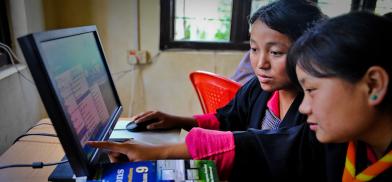60% additional data for e-learning in Bhutan
Studying online could become cheaper for students in Bhutan with the government approving an additional 60 percent data on the existing package. This means a student would receive 60 percent extra data for the same price

Studying online could become cheaper for students in Bhutan with the government approving an additional 60 percent data on the existing package. This means a student would receive 60 percent extra data for the same price.
Department of IT and Telecom officials said that under this incentive, data would be accessible from 7am to noon. Students can access only selective e-learning sites that include Google Classroom and GSuite apps, YouTube, Moodle, eLibrary and Zoom, among others.
A DITT official said that those students who have not applied for the package should submit their mobile numbers to the education ministry.
The official said that discount packages targeting students were prepared in consultation with the two telecom companies.
However, he said that given the mobile network capacity, there could be further congestion if they decide to provide similar discounts to the general public.
Access to the internet has become a challenge for many as more people try to work, educate and entertain themselves online due to the coronavirus pandemic.
According to the department’s annual report 2018-2019, there are 598,738 people with 3G mobile internet connection, including 208,003 with 4G connection.
Officials from the department said that the majority of Bhutanese depend on mobile broadband for internet access once they are outside their working area.
In such a situation, an official said that when the working population has to work from home, the traffic on the mobile network increases substantially. “Also, the demand for internet access is growing every year,” he said. “For these reasons, the department feels there is a need to invest in other forms of internet connectivity.”
He said that the best option for Bhutan would be fibre connectivity to all homes. However, because connecting every home with fibre optic cable is expensive, other options like wireless and copper cable connectivity are being explored.
“The idea is to create a network of fixed broadband infrastructure, especially in densely populated cities so that the connectivity to the internet can be spread to other infrastructure besides the mobile network.”
He said that for now, efforts to decongest mobile network is continuing in partnership with internet and telecommunication service providers (ISPs and TSPs) in the country.
He said that the working population is encouraged to subscribe to fixed broadband services like ADSL connection (home broadband) or leased line services (wired/wireless) so that the congestion on mobile networks is reduced.
DITT is also working with the two telcos to reduce rates for broadband and leased line connections so that some of the users would migrate to the wired infrastructure and help decongest mobile network.
He said that a comprehensive strategy document with multiple options is being developed and once complete would be submitted to the government.
After addressing the present issues brought about by the Covid-19 pandemic, he said that the two telcos could upgrade the capacity of their existing networks, so that the mobile base stations would be able to handle the increased users.
While the existing infrastructure can serve the current demand, the idea is to improve the capacity of the existing network to cater to near-future demands. However, up-gradation would take at least eight months with current lockdown situation across the world.
Proposals for expansion submitted by the TSPs are under review.
Third international internet gateway
Even after years of discussion to bring about redundancy in the international internet connectivity, Bhutan’s international internet connectivity continues to be at the mercy of the chicken’s neck corridor in Siliguri, India.
The attempt to establish the third international internet gateway from Bangladesh via Samdrupjongkhar still remains on paper. Bhutan today has two international internet connectivity through Siliguri to Phuentsholing and Gelephu.
DITT officials said that the department is currently negotiating with the Indian and Bangladeshi governments.
The establishment of the third gateway would primarily address the reliability issue and thus, help in the establishment of true redundancy in international internet connectivity.
“The third gateway will be established to significantly increase the reliability of internet connectivity for Bhutan. And reliable internet connectivity would also make it attractive for Foreign Direct Investment (FDI) in IT/ITES including data centre businesses in Bhutan,” the official said.
Bhutan today has more than 41 Gbps (Gigabits per second) of international internet bandwidth, of which only 50-60 percent is used. “Both the telcos are continuously monitoring the international bandwidth to ensure that they upgrade it if there is any increased usage.”
https://kuenselonline.com/60-additional-data-for-e-learning/









Post a Comment